Illustrating Tulsa's new city election procedure
I'm hearing that minions of Mayor Bynum IV are putting the word out that voting for one of his conservative opponents in the August 25, 2020, election will help elect someone further to the Left than the left-of-center Bynum. The rumor is self-serving garbage, preying on ignorance of the confusing new election process that Bynum IV and friends quietly slid into the charter three years ago, the sixth change to the city election process in 11 years.
Here's the truth: Unless one candidate has the support of 50% of the voters on August 25th, there will be a runoff in November with at least two candidates. Putting it another way: If a majority of voters vote against incumbent Bynum IV, and if a majority of voters also vote against Greg Robinson, the leading registered-Democrat candidate, neither will win the election outright on August 25.
The crucial task for conservative Tulsans who want a conservative mayor is to unite on August 25 behind one of the two conservative alternatives to Bynum (Ty Walker or Ken Reddick) so that we have a real conservative to vote for in November and Bynum can retire from being a failed mayor and resume his career as a schmoozer.
2020 is the first Tulsa mayoral election that will use the new election procedure approved by voters in a low-turnout November 2017 special election. (Only charter amendments on the ballot; only 10,425 votes were cast on this ballot item compared to 58,848 in the June 2016 mayoral primary. There ought to be a state law limiting city charter changes to high-turnout elections, or perhaps setting the threshold as 50% of the votes in the previous presidential election.)
Here is a direct link to the current charter language, Article VI, Section 2.2. Here's the key language:
If a candidate for office is unopposed at the election or becomes unopposed by death, disqualification or withdrawal, such candidate shall be deemed elected. If a candidate for an office receives more than fifty percent (50%) of all votes cast for that office at the election, such candidate shall be deemed elected. If more than two (2) candidates file for an office and no candidate receives more than fifty percent (50%) of all votes cast at the election for that office, the names of the several candidates for the office receiving the greatest number of votes totaling fifty percent (50%) at such elections shall be placed on the ballot at a run-off election in November, on the day specified by the laws of Oklahoma, and the candidate receiving the greatest number of votes cast at said run-off election shall be deemed elected. In the event of a tied vote among the said candidates, the election shall be decided by lot.
The same process applies to election for any Tulsa city office, including city councilors and the city auditor.
Note that the runoff may involve only two candidates, but if votes are split evenly enough between the candidates, it may involve more. Here are a few possible scenarios. Note that the numbers are entirely made up -- I have no polling data -- used simply to illustrate how different spreads of votes among candidates will lead to different runoff possibilities.
Scenario 1 is simple: If a majority of the August 25 voters support one candidate, he is elected to a four-year term as mayor. This is what happened in June 2016.
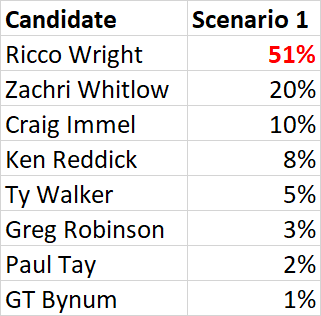
In Scenario 2, no one gets a majority of the votes on August 25, but the total of the top two is greater than 50%. In the illustrated scenario, Robinson and Bynum are the top two ranking candidates, and the sum of their percentage is 60%, so those two candidates advance to the November runoff. Note that in this hypothetical scenario, the two conservative candidates, Walker and Reddick, have enough votes that if they had all coalesced behind one of the two, the conservative candidate would have beaten out Bynum for the 2nd spot in the November runoff.
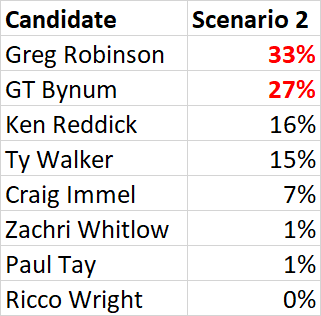
Scenario 3 illustrates what happens if the top two candidates fall short of a combined 50% total. In this case, Robinson and Walker would combine for 49% of the vote, so the third-place candidate, Immel, also would advance to the November runoff. Since those three combine for 68% of the vote, the condition would be satisfied, and no more candidates would advance to the runoff.
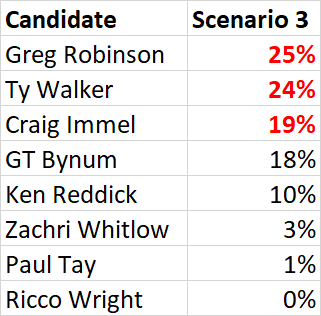
Scenario 4 is an extreme example to illustrate what would happen if the voters were very evenly spread among all seven of the active candidates. The top three candidates combine for only 46%, so one more candidate would have to be added to the November runoff ballot to reach the 50% threshold.
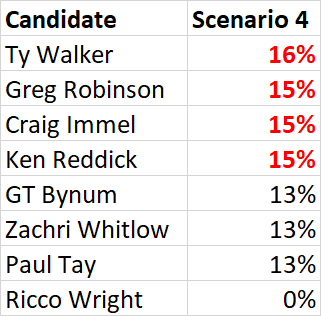
Scenario 5 is the most extreme hypothetical of all. Supposing all eight candidates got exactly the same number of votes -- 12.5% each. In this case, four candidates would advance (because the language says "totaling 50%," not exceeding 50%), and which four candidates advance would be decided by lot.
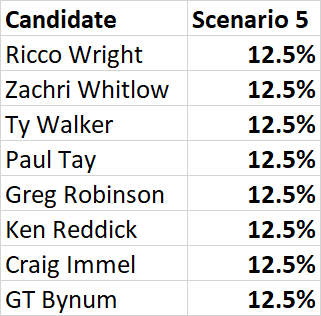
Note that there is no runoff after the November runoff. If more than two candidates advance to the November runoff, the election becomes a first-past-the-post race -- the candidate with the greatest number of votes, even if well short of a majority, is elected.
0 TrackBacks
Listed below are links to blogs that reference this entry: Illustrating Tulsa's new city election procedure.
TrackBack URL for this entry: https://www.batesline.com/cgi-bin/mt/mt-tb.cgi/8723